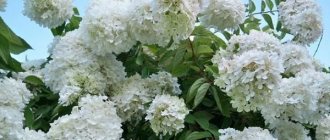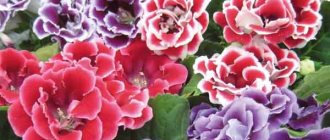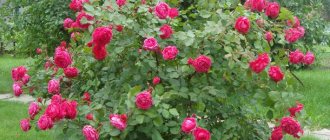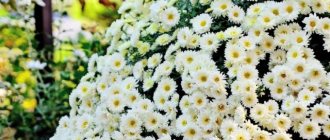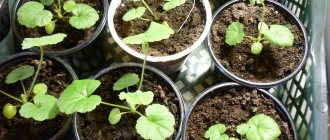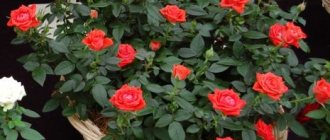Lovers of bright but unpretentious flowers happily decorate their garden plots with graceful evergreen shrubs or semi-shrubs of lavender, on which from afar you can see many flowers of various colors and feel a pleasant, intoxicating aroma, distinguishable among the fragrances of other flowering plants.
Cold-resistant garden lavender (photo) prefers poor, rocky, well-drained and calcareous soil. It is planted along paths as a hedge, along the edges of green lawns, and with single bushes they decorate the center of a flower bed in a sunny place near the house. Many heat-loving varieties of lavender do well in pots and complement indoor spaces on lighted windowsills in winter. In summer, containers with bushes are exposed to the open air in warm places protected from the cold wind.
Lavender of heat-loving varieties can also overwinter in a frost-free greenhouse. Lavender is a perennial plant; it can grow in one place for 6-8 years. Then the old bushes need to be replaced with new ones. This page of our website provides types of lavender (photos) and a description of dwarf, medium-sized and tall plant varieties.
Environmental requirements
Lavender requires plenty of sun , well-drained soil and excellent air circulation. The bed for the crop is prepared in advance by digging up the soil using a spade, adding a little compost and wood ash. The seedlings are planted in a permanent place when the danger of frost typical for the area has passed. Lavender doesn't need a lot of water. Between irrigations, allow the soil to dry thoroughly before watering again.
In autumn, young grass shoots are cut to 2/3 of the length of the stem, avoiding touching old branches. If the gardener lives in an area where there is little snow, then the plants need to be additionally covered with straw or dry leaves, and then with burlap. This will protect frost-resistant lavender from dry winds and extremely low temperatures. In the spring, when it gets warmer, the burlap and mulch are removed.
Reproduction
The plant reproduces in different ways, including:
- seminal;
- layering;
- cuttings.
The seed method is the most difficult. It requires seed stratification, after which seedlings are grown. The other two are more affordable. They are most often used by gardeners.
By layering
The description of this method is quite simple. Many garden crops are propagated by layering. To do this, you need to dig up a small part of one of the stems of an adult plant with loose soil. First, the shoot is secured with wire at the point of contact with the ground. Within a few weeks, roots will form in the place where the branch touches the ground. As soon as the baby begins to grow, the branch can be separated from the mother plant.
Cuttings
To do this, a woody one-year shoot is separated, from which fresh branches grow. The branches are trimmed, the shoot is placed in a pot with loose, moist soil. It should consist of garden soil and compost. Place a bag or plastic cap over the pot.
Propagation by deepening cuttings
In order for field lavender to start growing faster, the petioles are ventilated and watered daily.
Practical uses of lavender
This herbaceous plant is grown for several reasons. Lavender has medicinal properties, an intoxicating aroma, and flowers ranging from purple to white. Spectacular flowering continues throughout the summer season.
Lavender is also a honey plant whose flowers are loved by bees. From the collection of this nectar, unique honey is obtained.
A bag of lavender can repel moths from the linen closet and unwanted insects in the garden, and will also help a person get rid of insomnia. Dried buds can be used in cooking to add a unique yet spicy flavor to both savory and sweet dishes.
Herbal lavender teas help you relax, and essential oils help heal damaged skin.
About the plant
When does Lavender bloom?
The herbaceous perennial attracts attention with its rich blooms. Flowers can be purple, cornflower blue, pink. Another reason why gardeners adore the shrub is its subtle aroma. Many people know what lavender smells like. Today, the plant is also grown for industrial purposes, including for adding to perfumes. The smell of lavender is gentle and fragrant. Despite the sultry summer flavor, you can feel the cooling notes in it.
Note! The lavender scent is moth-resistant. Manufacturers of plates against annoying insects use this.
Characteristics
What does lavender look like? Among the characteristic features of a spectacular culture are the following:
- evergreen and lush shrub;
- the height of different varieties ranges from 15 to 95 cm;
- the rhizome is powerful, goes 150-220 cm into the ground;
- stems are branched, mostly erect;
- each shoot is covered with a coating resembling felt;
- the base of the bush gradually becomes woody;
- foliage is numerous, leaves are small, lanceolate;
- The color of the foliage is emerald-silver, it can be green with a bluish tint, there is also a variegated shrub;
- flowering lasts from 20 to 40 days, mainly beginning in June;
- what a lavender flower looks like - small flowers have an irregular shape, they are collected in spikelets and are located in the upper part of the bush.
Family
Lavender is a member of the Lamiaceae family. Another name for the family is Lamiaceae. It brings together many well-known herbs used as seasonings. For example:
- ü mint;
- ü lemon balm;
- ü oregano;
- ü basil;
- ü rosemary, etc.
The family includes representatives that resemble lavender in appearance. Flowers similar to lavender in appearance:
- ü hyssop;
- ü meadow sage;
- ü catnip;
- ü plectranthus.
In the wild, purple shrubs can be found in southern Europe, the Canary Islands, Africa, Australia and areas near the Mediterranean Sea.
Types of Lavender
The most frost-resistant variety of English lavender is Lavandula angustifolia. It blooms earlier than other representatives of the species and has short stems. Its flowers have a sweeter aroma, but contain less camphor in the essential oils.
The second type of lavender that can overwinter in the middle zone is Lavandin X, a hybrid of Lavender angustifolia and the slightly less frost-hardy Lavandula spicata. The Lavandin X hybrid features taller flower stems and larger plants, as well as slightly delayed flowering. The essential oil contains a large percentage of camphor, which gives the plantings a stronger, sharper and cleaner smell.
Both the above mentioned types have many varieties bred and selected for quality characteristics and purpose.
They are mainly used:
• for filling sachets with dried buds;
• making dried bouquets;
• as a culinary spice;
• in the form of essential oil extracts;
• like beautiful garden flowers.
Dwarf blue
The main decoration of the evergreen subshrub is the gray-blue flowers collected in spikes. They bloom in mid-summer. The height of the dwarf blue lavender bushes reaches 40 cm, and their diameter does not exceed 50 cm.
It feels best in a well-lit and draft-free place. Prefers alkaline soil. Therefore, wood ash and phosphate flour are perfect for it as fertilizers.
English varieties of lavender
'Munstead' is the hardiest variety and has light purple flowers with narrow green foliage. It can be propagated by seeds, stem cuttings, or purchased young plants from a nursery. This variety grows to 30-45 cm in height and, once established, will not require much care other than snowy winter protection. Lavender is a versatile plant with a strong aroma, but its stems are often twisted. Therefore, it is more suitable for drying flowers and buds than stems. Manstead easily tolerates winter temperatures in the range of -10 ... -23°C.
'Hidicote' is also very frost hardy. It has straight stems (medium to long) and is excellent for cutting. The foliage of the variety is gray, and the flowers are more purple than blue. The bush is lower than "Munstead", the maximum height is only about 28 cm. Its petals have a deep, rich color, so the variety is often used for drying, since after this the brightness is preserved almost in its original form. Even after drying, the flowers and stems continue to emit a delicate, sweet lavender scent. Resistant to frosty winters (-15...-22°C) , but prefers reliable snow cover or additional winter protection.
'Twickle Purple' is a lavender English lavender with a very long stem. The variety is one of the most cold-resistant varieties with long branches. It has a wonderful smell and is an excellent honey plant. 'Twickle Purple' is taller and more showy than 'Munstead' and has clumps of beautiful lavender inflorescences that look great in the garden. The long stems are suitable for drying or using lavender sprigs for bouquets. The variety has one drawback: after drying, the color of the petals fades greatly.
"Phenomenal" is a new hybrid of cold-resistant lavender, which is cultivated in frosty climates. Its bushes grow much taller than 'Hidicote' or 'Munstead', reaching a height of 60-85 cm. 'Phenomenal' has silvery foliage with violet-blue flowers and a bush form very similar to French lavender. It contains the largest amount of essential oil of any lavender variety and is an excellent honey plant. The variety is good for use in fresh or dried flower arrangements. Although Phenomenal enjoys hot, humid summers, it is also very tolerant of cold temperatures, especially if it has reliable snow cover. If the thermometer constantly drops down and frosts intensify, it is recommended to provide the plant with additional shelter. For a stunning flowerbed look, plant several varieties of lavender side by side, placing 'Phenomenal' at the back, 'Munstead' in the middle and 'Hidicote' at the front. “Phenomenal” seedlings should be spaced 100 cm apart from each other, “Munstead” plants should be spaced 50 cm apart, and “Hidicota” plants should be spaced 30 cm apart. During flowering, together they form a magnificent combination of shades from blue to lilac.
Lavender angustifolia 'Little Lottie' is a dwarf variety of English lavender that grows to about 30cm in height. The variety has pale, purplish-pink flowers set above green-gray foliage. Winter hardiness is not bad, but low-growing grass is intended for growing in a hanging basket; it is recommended to bring it, along with the pot, into a room with above-zero temperatures for the winter. When grown in open ground, “Kroshka Lotta” can withstand frosts in the range of -5...-7°C.
Lavender angustifolia “Lady Anne” is a compact variety of English lavender, the maximum height of the bush is approximately 45 cm. The flowers are pale pink with a light, unobtrusive aroma. When planted in open ground, “Lady Anna” combines well with medium-sized varieties, having purple buds. Without shelter it overwinters at frosts no higher than -3...-5°C.
Lavender angustifolia "Lullaby Blue" - the bush is strewn with rich purple-blue flowers. Plants reach about 60cm in height, making this a good choice if you need a flower hedge along paths. It is an excellent honey plant, frost resistance is low down to -5°C. With good winter shelter, it can be grown in areas where winters down to -20°C are not uncommon.
How to grow and care in St. Petersburg
Although lavender is a heat-loving plant and seems to be contraindicated in the northern regions, it is still possible to grow it in the Leningrad region. True, here we will have to limit ourselves only to those varieties that are bred specifically for such climatic conditions. In addition to the English lavender itself, which, as we saw earlier, is frost-resistant, two varieties of it are suitable here: “Munstead” and “Hidcote”. The second variety is slightly taller than the first, it grows up to 50 cm.
It is recommended to plant lavender exclusively as seedlings. This is done at the very beginning of the season so that the plant can adapt to the special climatic conditions of a given region.
While the seedling is taking root, it needs regular watering, which can later be reduced.
Also, the plant needs enough sun, so it is best to plant the plant on the sunny side of the garden.
It is not recommended to plant lavender bushes too often. She needs good ventilation. The plant grows well in flower beds. In addition, you can plant it in pots.
For the winter, lavender is covered, but with the end of frost, even if all the snow has not yet melted, it can be opened. In the spring, when young shoots appear, old dry branches must be removed. After flowering has finished, you can prune it.
French varieties of lavender
Three Lavandin varieties are currently at the peak of popularity - Grosso, Provence and Fred Boutin.
"Grosso" is a good frost-resistant variety. Withstands temperatures down to -20°C, but only if there is good snow cover. In cold, snowless winters, it requires additional ground shelter, otherwise it may freeze to death. This plant grows smooth, long stems covered with purple flowers.
“Fred Butin” - the variety is resistant to moderate frosts (-10...-12°C). The plant has light-colored leaves and pale flowers. It is highly decorative, thanks to which it perfectly fills free areas in the garden. It prefers mild winters, so you should not try to grow the variety without shelter further than the middle zone.
"Provence" - This is Lavandin X with a long stem, which is bred in order to collect the inflorescences after drying. Has an amazing aroma. Its amazing buds are used in “Herbs de Provence”, and the dried buds are the most aromatic of all known varieties. Does not tolerate severe frosts well. Without shelter, winter losses from plant death are 40-95%. Suitable for growing in milder climatic conditions, for example in Crimea or Krasnodar. Frost resistance in the region -5...-7°C.
Lavandula stoechas Willow Vale is a powerful variety of French lavender with stunning clusters of purple flowers. It has large and characteristic bracts. The flowers are used for drying and are removed from the plant as soon as the buds open. When planted in secluded places protected from northern winds, it grows without additional insulation, withstanding winters down to -10°C.
“Fathead” is a vigorous French variety with a pronounced, pleasant aroma, good for drying. As a garden bed, it prefers sunny, weather-protected places with well-drained and aerated soil. The inflorescences of this variety are rich in nectar and are an excellent honey plant. Combining the production of raw materials for the cosmetics industry with beekeeping, Fathead plantations have apiaries nearby. Winter hardiness is good. The variety is recommended for temperate climates.
Harmful insects, fighting them
Both field lavender and ornamental shrub attract bees. Honey made from the pollen of this plant has a pleasant aroma. But it's not just bees that choose the sophisticated perennial. Among those who enjoy lavender:
- ü aphid;
- ü agalmatium biloba;
- ü spider mite;
- ü chrysanthemum nematode.
The difference between bees and the listed pests is obvious. Bees do not harm the plant. While these microscopic creatures destroy the bush.
To combat, both chemical and folk remedies are used. Among the popular ones, dusting the bush with fly ash and treating it with soapy water stand out.
Additional Information. Among the effective drugs for controlling lavender pests are Neoron, Thiamethoxam, Alatar, Molniya extra, etc.
Lavender is a wonderful decoration for both the garden and the interior of the apartment. It doesn't matter which variety is chosen. Even a novice gardener can cope with growing a useful plant. The main thing is to immediately plant the shrub in a sunny place with loose soil.
How to let lavender overwinter without loss
Lavender needs well-drained soil. Without this, the melting winter snow will saturate the soil and kill the plant. Planting on a slope or installing drainage under the bed (beds of sand and gravel), as well as planting a plantation on a hill, will allow you to grow lavender on heavy clay soils.
The deeper the snow cover, the better. You can additionally throw snow on the lavender bed. Plants are warm under the snow; the temperature under such shelter never drops below zero. Mulching with straw or spruce branches can also help.
When setting up a plantation, you should choose a place protected from the wind, which will significantly reduce the likelihood of the plantings freezing. You should also remember that plants grow better in the ground than in pots. The soil in containers freezes quickly, so the root system may die.
Recommendations for planting
The plant loves nutritious, breathable soil. The place for the perennial is selected taking into account its love for the sun. It is not allowed to plant ornamental crops in a flower bed next to which water stagnates. Spring is suitable for planting, after all frosts have passed.
Variety of perennial varieties
Important! Only alkaline soil is suitable for perennials. Compost and coarse sand are added to heavy clay soil. Liming is also necessary.
The hole should be large. The root system of the seedling with a lump of earth is placed in it. The planting is mulched with compost and covered with a plastic cap. The cap is removed daily for ventilation. After 15-20 days, rooting occurs. The cap is no longer needed.
Variety type
Lavender Sineva is a narrow-leaved variety. This is a perennial, evergreen subshrub belonging to the Lamiaceae family . In nature, this variety of lavender can grow even in rocky soil, which is why the plant has a deep root system. If the narrow-leaved lavender Sinev is provided with proper shelter for the winter, it will safely endure the frosts.
In another way, this type of lavender is called “English”, since several new varieties were bred in England.
Rules of care
In order for lavender to grow well after planting, regular feeding and watering are necessary.
Watering
Watering is carried out abundantly, soaking the top layer to a depth of 10-15 cm. On hot days, watering is increased, in cool summers - reduced.
Fertilizer, pruning
During the summer, the soil around the seedlings is carefully loosened and watered regularly. At the end of August, young plants are transplanted at a distance of 50 cm. In the first winter, the seedlings should be covered with spruce branches and on top with covering material.
Removal of the shelter is possible at the end of April. After this they begin to feed. For the first time, a solution of nitrogen fertilizers is used. 2 tsp urea is dissolved in 10 liters of water. 1 liter of fertilizer is poured onto each plant.
In June, fertilizing is repeated. During this period, slurry or green fertilizer is used. Manure or grass is pre-soaked in a ratio of 1:10. Then 1 liter of the finished composition is dissolved in 10 liters of water. This amount is enough to feed 10 lavender bushes.
A second thinning should be carried out in August. Now the distance between the lavender bushes is left 80 cm. After 10-15 days, a third feeding is carried out. At this time, you can use the ready-made mixture for autumn filling of the soil. Dissolve according to the instructions on the package.
On a note! In order for lavender bushes in the country to begin to grow quickly, high hilling is used, after which the soil around is mulched with dry hay or fresh grass.
In subsequent years, caring for lavender requires the use of 3 feedings during the season. The first one should be given with nitrogen fertilizers, and the subsequent ones with phosphorus-potassium fertilizers. It is better to fertilize with mineral flower mixtures.
In April, mature plants require maintenance pruning. Using pruning shears, cut out all dried and unnecessary branches that spoil the appearance of the bushes. After summer flowering, remove all wilted inflorescences. To maintain a neat shape, in September the branches that have stretched over the summer are cut off.
Ten-year-old bushes require rejuvenating pruning, during which the length of the branches is left no more than 50 cm. Such radical pruning can enhance the flowering of younger bushes if they are lagging behind in development.
Botanical description
Before purchasing lavender seeds of this variety and sowing them, you should familiarize yourself with its botanical description (this will help you get an idea of the future plant):
- Stems . The height of the stems of an already mature and formed bush reaches 65-70 cm. They are branched, by the end of the 1st year of life the shoots become woody at the base.
- Leaves . They have a narrow shape, 2-6 cm in length, drooping, colored in a grayish-green tint.
- Flowers . They have a classic purple color. Lavender begins to bloom in June and continues to bloom until the end of August. At this time, the lavender bush is covered with a large number of narrow inflorescences that look like blue-violet spikelets. Each flower is small - up to 1 cm in length. When it blooms, it forms a small fruit.
- Root system . It is rod-shaped, with branches, deep-lying (in some cases reaches a length of 4 m).
- Seeds . They usually ripen by September. The seeds are medium in size, glossy, and purple in color.
- Features of the aroma . Lavender variety Sineva exudes a pleasant and pronounced aroma.
This is what lavender Sineva looks like in the photo:


